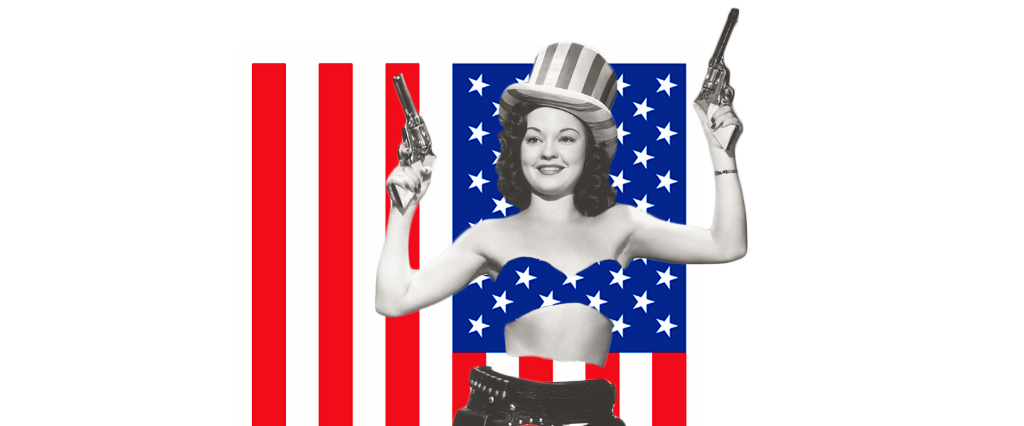When Bob Flora, the former art director of Hustler, told Julie Brady, a seamstress whose sister happened to go to school with Flora, to make something “patriotic” for an upcoming cover, she just so happened to be all out of white fabric. In a pinch, she turned to her wedding dress, cutting out portions of it to represent the “purity” of America’s red, white and blue iconography. Those cuts of fabric were then repurposed into a tiny, American flag bikini bottom. She was paid around $100 for her work, which ended up on the cover of the July 1976 issue. It’s one of the most controversial covers in the history of a very controversial magazine.
More largely, though, she ushered in the dawn of the American Flag bikini. And pretty much ever since, hot girls across the country — on both the right and the left — have donned bikinis with the American Flag printed on them (most especially on the Fourth of July) as the official mark of patriotism/America/the flag being sexy. For example, just yesterday, the following posts popped up on Instagram:
Now, depending upon who you ask, wearing a flag bikini might be against flag code in the same way that an American flag isn’t supposed to touch the ground. Others, however, interpret flag code as only referring to wearing the actual American flag, not simply the print. Either way, it makes it ironic that die-hard flag defenders like Tomi Lahren, who has criticized NFL players who kneel during the National Anthem for “disrespecting the flag,” would find it so acceptable to wear it like a pair of bat wings.
Generally speaking, flag historian Marc Leepson, author of Flag: An American Biography, says that Americans have had a near-religious relationship to the flag since the mid-1800s. So much so that by the 1890s, children were pledging their allegiance to the flag every day in school. “Americans have a unique feeling for our flag, and it’s expressed in different ways that you won’t find anywhere else in the world,” he says.
Though wearing prints of the flag is indeed technically against flag code according to Leepson’s interpretation, he cites mass production and consumerism as the impetus for the American Flag bikini (beyond, of course, Brady’s handiwork). Plus, the rhetoric of patriotism has historically been that a woman’s role is to reproduce in order to bolster the nation — the most notorious example being Nazi Germany’s “Cross of Honour of the German Mother,” given on a basis of how many children a woman birthed.
With that in mind then, what could be more patriotic and demonstrative of a love for one’s country than baring its symbolism upon one’s own body? To drop the flag upon the ground is desecration, but to drop an American Flag bikini to the ground for the sake of procreation is a kind of reverence. “I suspect the close link between the patriotism and eroticism of flag-printed bikinis got its start in the historical context of early Cold War anxieties and then took off by the early 1960s — at the height of Cold War tensions — but also at the height of postwar consumer abundance, the emerging playboy culture (thanks, Mr. Hefner) and the sexual revolution itself. Remember, the pill first came online circa 1960,” Brendan Goff, a history professor at my alma mater (New College of Florida), theorizes.
Dustin Kidd, a professor of popular culture at Temple University, cites the concept of the American Flag as a design as originating from Jasper Johns neo-Dada 1954 painting Flag. “Between that painting and Andy Warhol’s general smashing of the barrier between high and popular culture, the road was paved for the sacred image of American citizenship to be transformed into a hot, and at times, sexy commodity,” Kidd explains.
And so, while sexy patriotism wasn’t exactly new before that July 1976 cover of Hustler — most famously, there were Mae West’s 1938 Vanity Fair photos, in which she dressed as a sexy Lady Liberty — the direct contact between a woman’s vagina and an American Flag was much more provocative. Not to mention, it was a simple product a woman could purchase and wear herself.
That said, it wasn’t until the 1990s and early 2000s that the flag bikini hit a saturation point — with it appearing on everyone from Cindy Crawford to the women of American Pie to Kim Kardashian, Nicki Minaj and Pamela Anderson. According to the son of a former flag retailer with stores across the country, in the years following 9/11, sales of American Flag-printed bikinis put food on his table when flag sales were otherwise declining. “If you wanted to be the hot girl at the pool in the summer in the early 2000s, that’s what you wore,” says the man, who asked to remain anonymous.
These days, there are a number of Instagram accounts devoted to compiling photos of “patriotic hotties” and “sexy babes with ole glory,” such as @rwb_babes. These accounts repost photos from other models and photographers of women in — you guessed it — American Flag bikinis, or occasionally just a woman in lingerie posing in front of the flag. Almost every photo is captioned with something about “making America great again.”
None of this, of course, was Brady’s intention. “All [Flora] said to me was ‘patriotic,’ and I went with the flag idea,” she says. “It was quite by accident that I had that white fabric and was a seamstress of sorts! And kind of interestingly accidental that I utilized the flag idea — like thinking it must be sacrilegious or something!”
Sacrilegious or not, the rest is American history.

